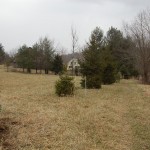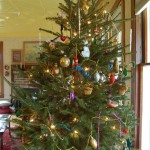
a line of spruce trees looking back toward the house
My husband and I have been tree huggers since before we met and one of our most enduring traditions is planting a solstice tree every year on or about New Years Day.
Planting a living being that will hopefully outlive you is a very positive way to start a new year/rotation of the sun. Even on those days when it was cold, muddy, windy etc. and all I wanted to do was stay inside, I warmed with the work and felt very satisfied with my small contribution to Mother.

all decked out 2013
This years tree is a Norway Spruce. We favor spruce out here over pine because pine is like chocolate to a deer, not that they can’t damage a spruce tree by rubbing antlers on the trunk. Weird fencing usually thwarts this, I have also used some of the spray repellents but beware they smell BAD and if it’s close to the house well, ……….yuck
That reminds me of a funny story, one year our tree was waiting outside for it’s big week (that’s right only ONE week indoors) and I was sprinkling kelp water on some outside shrubs when I had a brilliant idea, kelp is for stressed out plants and a newly dug tree was surely stressed, so I thoroughly doused said tree in fishy kelp.

Cali kitty keeps company

on the porch ready to go out to the field
After my ever patient spouse washed the offending tree three or four times and we tried to shake off most of the extra water, it still smelled. Not so much that we didn’t give it a week of glory with all the trimmings! And maybe a spritz of scent. I think I went thru an amazing amount of scented candles that year.

Where’s Jay? He’s pulling a Tree.
Once the week of glory is over and its time to plant the tree, a hole must be dug. We favor smaller trees. They are easier in all respects and more likely to survive. Some tips for the survival of a newly planted tree: Dig your hole wide, but only as deep as the original rootball.

Dig the hole wide but only as deep as the rootball
Fall and early winter are great times to plant trees as the roots will grow all winter. For the first year fertilize lightly and water heavily.
The last step when planting especially in winter is mulch. We do a whole bale of hay, laying out the flakes in layers around the trunk. This helps prevent heaving by insulating the rootball.

hauling hay under the watchful gaze of Xena













